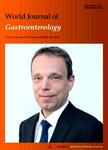High-fibre diet and Lactobacillus paracasei B21060 in symptomatic uncomplicated diverticular disease
High-fibre diet and Lactobacillus paracasei B21060 in symptomatic uncomplicated diverticular disease作者机构:Department of Digestive and Liver DiseaseUniversity SapienzaRome 2nd Medical SchoolSant'Andrea Hospital00189 RomeItaly Ospedale Nuovo Regina Margherita00189 RomeItaly Gastroenterology UnitOspedale Israelitico00148 RomeItaly Gastroenterology UnitOspedale San Giovanni00184 RomeItaly Medical Department Bracco Spa20134 MilanItaly
出 版 物:《World Journal of Gastroenterology》 (世界胃肠病学杂志(英文版))
年 卷 期:2012年第18卷第41期
页 面:5918-5924页
核心收录:
学科分类:1002[医学-临床医学] 100201[医学-内科学(含:心血管病、血液病、呼吸系病、消化系病、内分泌与代谢病、肾病、风湿病、传染病)] 10[医学]
基 金:Supported by The study was in part supported by Bracco Spa(Milan Italy)
主 题:Symptomatic uncomplicated diverticulardisease Lactobacillus paracasei B21060 Probiotics Symbiotics Diverticular disease High-fibre diet
摘 要:AIM: To investigate in symptomatic uncomplicated di- verticular disease the efficacy of symbiotics associated with a high-fibre diet on abdominal symptoms. METHODS: This study was a multicentre, 6-too ran- domized, controlled, parallel-group intervention with a preceding 4-wk washout period. Consecutive out- patients with symptomatic uncomplicated diverticular disease, aged 40-80 years, evaluated in 4 Gastroenterology Units, were enrolled. Symptomatic uncomplicated diverticular disease patients were randomized to two treatment arms A or B. Treatment A (n = 24 patients) received 1 symbiotic sachet Flortec~ (Lactobacillus paracasei B21060) once daily plus high-fibre diet for 6 mo. Treatment B (n = 21 patients) received high-fibre diet alone for 6 rno. The primary endpoint was regres- sion of abdominal symptoms and change of symptom severity after 3 and 6 mo of treatment. RESULTS: In group A, the proportion of patients with abdominal pain 〈 24 h decreased from 100% at base- line to 35% and 25% after 3 and 6 mo, respectively (P 〈 0.001). In group B the proportion of patients with this symptom decreased from 90.5% at baseline to 61.9% and 38.1% after 3 and 6 mo, respectively (P = 0.001). Symptom improvement became statistically sig- nificant at 3 and 6 mo in group A and B, respectively. The proportion of patients with abdominal pain 〉24 h decreased from 60% to 20% then 5% after 3 and 6 too, respectively in group A (P 〈 0.001) and from 33.3% to 9.5% at both 3 and 6 mo in group B (P = 0.03). In group A the proportion of patients with ab- dominal bloating significantly decreased from 95% to 60% after 3 mo, and remained stable (65%) at 6-mo follow-up (P = 0.005) while in group B, no significant changes in abdominal bloating was observed (P = 0.11). After 6 mo of treatment, the mean visual analogic scale (VAS) values of both short-lasting abdominal pain (VAS, mean ± SD, group A: 4.6 ± 2.1 vs 2.2 ± 0.8, P = 0.02; group B: 4.6 ± 2.9 vs 2.0 ± 1.9, P = 0.03) and abdom- inal bloat



